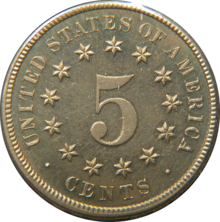
Back درع نيكل Arabic Shield Nickel German Pièce de 5 cents de dollar américain Shield French Moeda de 5 centavos de dólar Shield Galician Пять центов со щитом Russian П'ять центів (Щит) Ukrainian 盾牌镍币 Chinese
United States | |
| Value | 5 cents (0.05 US dollars) |
|---|---|
| Mass | 5.000 g (0.1615 troy oz) |
| Diameter | 20.50 mm (0.8077 in) |
| Edge | Plain |
| Composition | |
| Years of minting | 1866–1883 |
| Obverse | |
 | |
| Design | Shield representing the United States |
| Designer | James B. Longacre |
| Design date | 1866 |
| Reverse | |
 | |
| Design | Denomination surrounded by stars, separated by rays |
| Designer | James B. Longacre |
| Design date | 1866 |
| Design discontinued | 1867 |
 | |
| Design | Denomination surrounded by stars, rays removed |
| Designer | James B. Longacre |
| Design date | 1867 |
| Design discontinued | 1883 |
The Shield nickel was the first United States five-cent piece to be made out of copper-nickel, the same alloy of which American nickels are struck today. Designed by James B. Longacre, the coin was issued from 1866 until 1883, when it was replaced by the Liberty Head nickel. The coin takes its name from the motif on its obverse, and was the first five-cent coin referred to as a "nickel"—silver pieces of that denomination had been known as half dimes.
Silver half dimes had been struck from the early days of the United States Mint in the late 18th century. Those disappeared from circulation, along with most other coins, in the economic turmoil of the Civil War. In 1864, the Mint successfully introduced low-denomination coins, whose intrinsic worth did not approach their face value. Industrialist Joseph Wharton advocated coins containing nickel—a metal in which he had significant financial interests. When the Mint proposed a copper-nickel five-cent piece, Congress required that the coin be heavier than the Mint had suggested, allowing Wharton to sell more of the metal to the government.
Longacre's design was based on his two-cent pieces, and it symbolizes the strength of a unified America. The nickel proved difficult to strike and the reverse, or tails, design was modified in 1867. Even so, production difficulties continued, causing many minor varieties which are collected today. Minting of the Shield nickel for circulation was suspended in 1876 for a period of over two years due to a glut of low-denomination coinage and it was struck in only small quantities until 1882. The following year, the coin was replaced by Charles E. Barber's Liberty head design.
© MMXXIII Rich X Search. We shall prevail. All rights reserved. Rich X Search